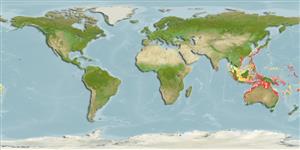Environment: milieu / climate zone / depth range / distribution range
Ecología
marino; agua dulce; salobre bentopelágico. Tropical
Distribución
Países | Áreas FAO | Ecosistemas | Ocurrencias, apariciones | Point map | Introducciones | Faunafri
Western Central Pacific: Australia and New Guinea.
Tamaño / Peso / Age
Maturity: Lm ? range ? - ? cm
Max length : 30.0 cm TL macho / no sexado; (Ref. 34016)
Occur inshore, in mangrove areas; in lotic and lentic freshwater bodies (Ref. 7300). Live in coastal marine waters, but also found in estuaries and freshwater sections of rivers (particularly in temperate southern latitudes) (Ref. 44894). Benthic omnivore, juveniles feed on algae and a range of small crustaceans, while older fish prey mainly on polychaetes (Ref. 34016). Eggs are guarded and fanned by the male parent (Ref. 205).
Life cycle and mating behavior
Madurez | Reproducción | Puesta | Huevos | Fecundidad | Larva
Eggs are guarded and fanned by the male parent (Ref. 205).
Paxton, J.R., D.F. Hoese, G.R. Allen and J.E. Hanley, 1989. Pisces. Petromyzontidae to Carangidae. Zoological Catalogue of Australia, Vol. 7. Australian Government Publishing Service, Canberra, 665 p. (Ref. 7300)
IUCN Red List Status (Ref. 130435)
Threat to humans
Harmless
Human uses
Más información
ReferenciasAcuiculturaPerfil de acuiculturaRazasGenéticaElectrophoresesheritabilidadEnfermedadesProcesamientoNutrientsMass conversion
ColaboradoresImágenesStamps, Coins Misc.SonidosCiguateraVelocidadTipo de nataciónSuperficie branquialOtolitosCerebrosVisión
Herramientas
Special reports
Download XML
Fuentes de Internet
Estimates based on models
Preferred temperature (Ref.
123201): 23.8 - 28.8, mean 27.6 °C (based on 416 cells).
Phylogenetic diversity index (Ref.
82804): PD
50 = 0.6250 [Uniqueness, from 0.5 = low to 2.0 = high].
Bayesian length-weight: a=0.01288 (0.00598 - 0.02775), b=3.05 (2.86 - 3.24), in cm total length, based on LWR estimates for this (Sub)family-body shape (Ref.
93245).
Nivel trófico (Ref.
69278): 3.2 ±0.1 se; based on diet studies.
Generation time: 2.7 ( na - na) years. Estimated as median ln(3)/K based on 1
growth studies.
Resiliencia (Ref.
120179): Medio, población duplicada en un tiempo mínimo de 1.4-4.4 años (K=0.06-0.41).
Fishing Vulnerability (Ref.
59153): Low to moderate vulnerability (29 of 100).
